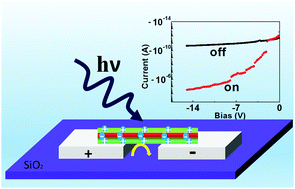An air-stable microwire radial heterojunction with high photoconductivity based on a new building block†
Abstract
Organic semiconductor materials with one-dimensional (1D) radial (core–shell) heterojunction structures are highly desired for their expected excellent optoelectronic properties. However, currently, such structures are still in a fledgling period for optoelectronic applications due to the absence of both good materials and suitable preparation methods. Here we have synthesized a p-type organic semiconductor based on a new electron-donating unit (dithienopyrazine) and utilized it as a shell material to construct organic 1D radial p–n heterojunctions. This p-type compound shows a higher oxidation potential and is more resistant to photooxidation in air than its analogs with the commonly-used benzodithiophene unit. Moreover, we prepared organic microwires with radial heterojunctions via a solution-processed method by self-assembly of our p-type material on the surface of n-type cores. Thus, photoconductive devices based on an individual microwire with the radial heterojunction can be fabricated and demonstrate a high photoconductivity. Our work provides a path for preparing 1D radial heterojunctions suitable for optoelectronic applications.


 Please wait while we load your content...
Please wait while we load your content...